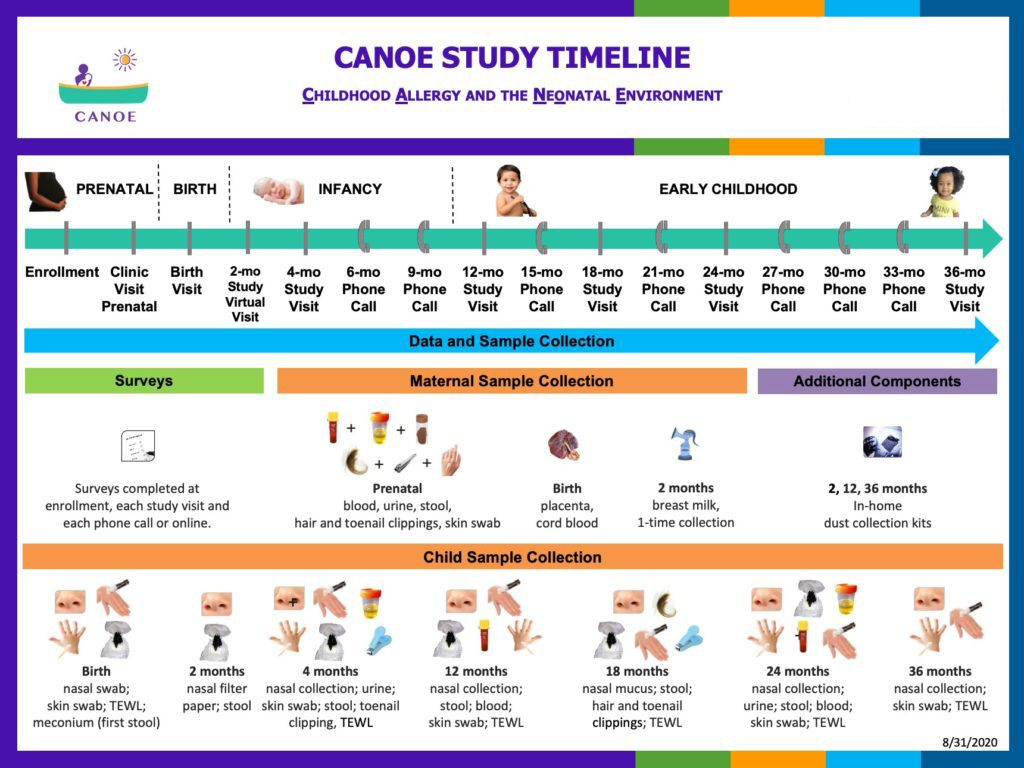The Childhood Allergy and the NeOnatal Environment (CANOE) Birth Cohort Study
CANOE is part of two larger NIH-funded projects: the Children’s Respiratory and Environmental Workgroup (CREW) and Environmental Influences on Child Health Outcomes (ECHO).

Asthma is more common in today’s children than ever before. Furthermore, the risk of childhood asthma is especially high if other family members have allergic diseases or asthma. Other studies have found evidence that environmental exposures during the prenatal and newborn periods could be very important in determining whether or not babies go on to develop asthma. Some exposures, including good types of bacteria and exposure to animals, may help the development of a healthy immune system. On the other hand, exposure to certain chemicals could promote allergies and asthma. Understanding these early life processes could help to guide development of new treatments to prevent asthma.
That is why we are starting the CANOE study. CANOE is recruiting expectant mothers for a research study to determine how early-life exposures influence the risk for developing childhood asthma and allergies.

Why participate?
- Participation in this study can help us learn about health and well-being that could benefit children, including your children and grandchildren in the years to come.
Who can participate in the study?
- Expectant mothers who have asthma, or the biological father of your child(ren) has asthma, and/or one of your children has asthma, allergies of the nose, or eczema
- Must be 18 years or older at the time of study enrollment
What to Expect
Procedures
Click each bullet to learn more about these procedures.
Demographics
We will collect your name, date of birth, email address, phone number, race, sex, gender, language, household information including address history, jobs, etc.
Physical exam
Height and weight, hip and waist circumference, heart rate, and blood pressure, for both you and your child.
Questionnaires
We will ask you to complete questionnaires and other forms about you and your child.
Blood
- We will use blood to study cells, proteins and other substances that can affect health. We will draw up to 2 tablespoons of blood from you.
- For your child, we will collect about 1 tablespoon of blood from the umbilical cord after childbirth. Then, once the child is 12 months old and again at 24 months old, we will draw up to 1 tablespoon of blood.
Placenta
We will collect the placenta after childbirth. The study staff will also photograph the placenta prior to processing the tissue. Researchers are interested in looking at signs of inflammation and environmental contaminants.
Breast milk
We will ask you to collect about 5 teaspoons of your breast milk (either in the clinic or at home using the collection kit). Researchers would like to look at signs of inflammation and other environmental contaminants. This will only occur one time during the study.
Urine
We will collect urine from you and your child during study visits or using a collection kit at home to look at signs of inflammation and other environmental contaminants.
Stool
We will collect a stool sample from you and your child during study visits or using a home collection kit to examine the bacterial and fungal content.
Hair/toenail clipping
We will collect a few strands of hair and a few toenail clippings from both you and your child, at a study visit or using collection kits at home. Researchers are interested in looking at environmental contaminants in the hair and the toenails.
Skin swab
We will collect skin swabs from you and your child. To do this, we take a swab (like a Q-tip) and pass it over the front of you and your child’s elbow multiple times to gather skin cells. Researchers are interested in looking at the microbes present on the skin.
Skin exam
Skin of the child will be examined for the presence of eczema.
Nasal sampling
We will collect several samples of cells and mucus from your child’s nose. This will start once the child is two months old. Researchers are interested in looking at the types of cells, the types of proteins, and environmental contaminants in the nose.
- Nasal swab & mucous: Nasal cells and mucus will be collected by putting a tiny swab (the size of a Q-tip) in the nose moved in and out for 4 seconds. The swab is then removed from the nose.
- Nasal filter paper: Nasal secretions will be collected by inserting an absorbent strip into your child’s nose for 1-2 minutes.
Saliva (spit)
Saliva will be collected from you by having you spit into a small collection container until your saliva hits the fill line. Your child will provide saliva by having his/her mouth swabbed with a Q-tip sponge. This sample will be used to look at your genes (DNA) in relationship to your health if you agree to genetic testing.
Assisted Collection
TEWL collections (transepidermal/water loss)
TEWL is the amount of water that naturally evaporates through skin to the environment. It is used to measure skin barrier function. We will measure this on your child multiple times. It is collected by using a commercially available wand that is passed over the skin several times.
House dust
Multiple dust samples will be collected from your home using a collection kit. We may ask you to sample more than one room in your house if your child spends time there. Researchers are interested in looking for allergens and other environmental contaminants in your home.
Follow up phone calls
The study team will call you at the 6, 9, 15, 21, 27, 30, and 33-month mark to check in, get updated contact information, and answer any questionnaires that need to be completed over the phone if they have not been completed yet. This call should not last more than 30 minutes.
Compensation
- You will be compensated for your time and participation in the study.
Interested in enrolling? Click one of the participating sites below for further details and contact information.